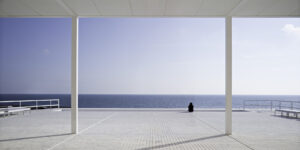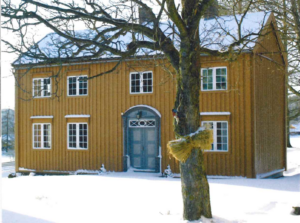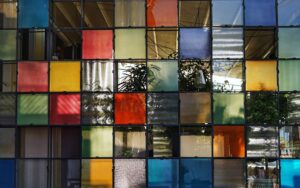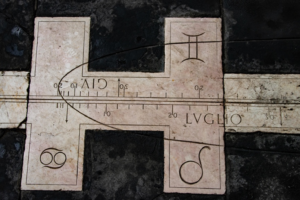Daylight Awareness Week 2023
Daylight and us: learning from the past?
13-17 November 2023
Celebrate daylight with us!

This year, the Daylight Awareness Week celebrated daylight thanks to different kinds of contributions and formats, published throughout the week. We looked at natural light and its significance from a historical perspective. Online talks, videos, articles explore how our relationship with sunlight and our knowledge related to it have evolved over time.
Has our perception of the sun changed over the centuries? Is there traditional knowledge or uses related to sunlight we should learn from? How did the invention of the light bulb influence the way we live? How has the relationship between architecture and natural light developed through time?
Get involved by sharing resources in relation to our topic, post about the importance of daylight through the ages, and use #DaylightWeek on social media to be part of the campaign. Let’s make daylight shine even brighter!
Each day of the week was devoted to a different theme, which was then explored through a range of methods and resources such as webinars, videos, podcast episodes or blog articles. Scroll down to see individual daily programmes for a more extensive list of materials.
Highlights
Recordings from this year’s webinars:
Dr Mónica Berger González, Medical Anthropologist at Universidad del Valle de Guatemala, talks about the place of the Sun in Mayan culture.
Prof. Christian Cajochen, Head of the Centre for Chronobiology at the University of Basel, talks about our awareness of the effects of daylight throughout history.
Dr Richard Hobday, engineer and expert in health in buildings, talks about the use of sunlight to treat diseases in front of one of Dr Rollier’s former sanatoria in Leysin, Switzerland.
by Alejandro Díaz-Infante R.

“Alberto Campos Baeza, the renowned Spanish architect, once wrote that light, like gravity, is an unavoidable aspect of architecture. According to him, every architect, as he does with the tape measure, spirit-level and plumb line, should carry a compass, and a photometer. The compass is necessary to measure the quality of the light by knowing the position of the sun, and the photometer to measure the quantity of light…”
Read more...by Barbara Szybinska Matusiak

“The most unique feature of this type of building [Trønderlåna] is that living rooms in the house run from one long wall to another. Also, the placement of windows directly opposite each other in the long walls, which provides an even light distribution and a rather high light level in interiors as compared to rooms with windows in only one wall…”
Read more...by Niloufar Tabandeh and Prof. Manuel Spitschan

“Daylight is vital for humans, as it illuminates the world and helps us navigate, read, and appreciate visual art. Light influences us profoundly beyond vision, namely by synchronizing our circadian clock and ensuring that we run on ‘environment time’.”
Read more...by Gerd Folkers

“The idea of putting a point of the sun on a cathedral floor through a hole in the roof or wall at noon and thus establishing the meridian, the north-south line, is an old one. It is believed that as early as the 8th century, monastery churches sporadically experimented with sun position indicators when they had a medieval polymath for an abbot…”
Read more...Jan-Frieder Harmsen
Oxford University Professor Russell Foster talks about how daylight has shaped life on Earth, how it changes over the course of a 24-hour day and more.
Listen to Part 1Jan-Frieder Harmsen
Professor Foster shares practical recommendations on how daylight and electric light can support health and well-being as well as providing an outlook on where the research around lighting and health is heading to in the future.
Listen to Part 2Overview of materials and resources published day-by-day
Click on the different days to see more detailed resources
(Illustrations by Marina Roa from SenseTribe)
In ancient times, the Sun held a place of profound significance in the beliefs, cultures, and traditional knowledge systems of various civilisations. The Sun, often regarded as a deity or a celestial force, played a central role in the mythologies, religions, and daily lives of these ancient societies. Its radiant presence in the sky was not only a source of light and warmth but also a symbol of power, creation, and cosmic order. The Sun’s movements, from the daily rise and setting to the annual solstices and equinoxes, were observed, and interpreted, shaping calendars, rituals, and agricultural practices. Traditional knowledge related to sunlight still plays a role in certain cultures and remains a fascinating aspect of our historical understanding and appreciation of this celestial body.
From 17:00 to 18:30 CET, a webinar featured the following talks:
Seventeenth-Century Sun Worship
by
Dr Sophie Battell
English Literature
University of Zurich, Switzerland
Plants, Sun, and People in Vanuatu
by
Dr Gregory M. Plunkett
Floristics and Molecular Systematics
New York Botanical Garden, USA
and
Dr Dominik M. Ramík
IT, Linguistics
Independent researcher, Tanna, Vanuatu
Webinar moderated by Dr Mónica Berger González, Medical Anthropology, Universidad del Valle de Guatemala
Online talk: Plants, Sun, and People in Vanuatu
by Dr Michael J. Balick and Dr K. David Harrison (2020)
“We are excited to embark on a long-term study of the importance that daylight holds for indigenous cultures in the Pacific Island nations of Vanuatu and Fiji. We will also seek a greater understanding of the impact of daylight on the quality and cadence of life for these islanders. Our initial impressions suggest there are several lessons that our society could learn from our neighbors in the Pacific…”
Read the postHow did Mayas perceive and relate to the Sun?
Dr Mónica Berger González, Medical Anthropologist at Universidad del Valle de Guatemala, talks about the place of the Sun in Mayan culture.
Daylight Awareness Week 2022: The Sun, Star of the Stars
Watch from 54’03”:
Talk by Prof. Giulio Magli, Archaeoastronomy, Faculty of Civil Architecture, Politecnico di Milano, Italy
A historical sociology perspective on our relationship with sunlight
Keynote speech held at the DLA Annual Conference 2021 by Dr Simon Carter, Faculty of Arts & Social Sciences, The Open University, UK
 “The history of architecture is the history of the struggle for light.”
“The history of architecture is the history of the struggle for light.”
(Le Corbusier)
The second day of the Daylight Awareness Week is devoted to the use and integration of daylight in architectural design through time. On 14 November, several articles around this theme have been published on the DLA Blog. Here is a short extract from one of them:
“Daylight has always been a constant feature in architecture, but the reasons behind its use have evolved over time. At times, daylight has been incorporated into buildings for its symbolic significance. Nevertheless, it has also served as the central aspect of an individual’s interaction with the structure.”
(Alejandro Díaz-Infante R.)
Take a look at the new blog posts:
Blog post
by Alejandro Díaz-Infante R. (2023)
“Alberto Campos Baeza, the renowned Spanish architect, once wrote that light, like gravity, is an unavoidable aspect of architecture. According to him, every architect, as he does with the tape measure, spirit-level and plumb line, should carry a compass, and a photometer. The compass is necessary to measure the quality of the light by knowing the position of the sun, and the photometer to measure the quantity of light…”
Read the postBlog post
by Barbara Szybinska Matusiak (2023)
“The most unique feature of this type of building [Trønderlåna] is that living rooms in the house run from one long wall to another. Also, the placement of windows directly opposite each other in the long walls, which provides an even light distribution and a rather high light level in interiors as compared to rooms with windows in only one wall…”
Read the postBlog post
by Gerd Folkers (2023)
“The idea of putting a point of the sun on a cathedral floor through a hole in the roof or wall at noon and thus establishing the meridian, the north-south line, is an old one. It is believed that as early as the 8th century, monastery churches sporadically experimented with sun position indicators when they had a medieval polymath for an abbot…”
Read the postby Colin Fournier (2023)
“The Circadian House is a small experimental dwelling unit for two people, with 15 multidirectional glazed openings, allowing it to be lit entirely by natural light, from dawn to dusk. The internal space is as open and uncluttered as possible, allowing the free play of light within the home…”
Read the postScience/AAAS, Washington, DC, 2017
“Daylight analysis has become an integral part of the architectural design process, particularly in recent decades. Increasingly sophisticated simulation models and analytical tools are being used not only to evaluate project alternatives, but also to generate optimal designs based on both daylight and artificial light…”
Read the publicationFor all of our planetʼs history, there has been night and day, driving the rhythms of life across days and seasons… until the invention of the light bulb. Now, we have light whenever we want it. But what light do we need when and why? How do our (day)light habits affect our health and well-being?
The 6th edition of the deLIGHTed Talks “History of Good Light – Beyond the Visual Spectrum” took place online from 15:00 to 16:30 CET with the speakers:
 Dr Priji Balakrishnan
Dr Priji Balakrishnan
Technical University of Berlin, Germany
Introduction
Prof. Timo Partonen
Finnish institute for health and welfare, Helsinki, Finland
Topic: Full daylight spectrum from a historical perspective
Dr Anne Berends
Seaborough, The Netherlands
Topic: Beyond the visible: the proven effects of near-infrared light on health and well-being
This webinar was moderated by DLA member Dr Priji Balakrishnan and organised in collaboration with the Good Light Group, the Society for Light Treatment and Biological Rhythms (SLTBR), and Luger Research.
with Russell Foster
As part of the Daylight Awareness Week, Prof. Russell Foster (Head of the Nuffield Laboratory of Ophthalmology, and Director of the Sleep and Circadian Neuroscience Institute at the University of Oxford) talks about the differential impact of daylight and electric light on health.
This resulted from a collaboration with Jan-Frieder Harmsen and his podcast 247MUSCLE.
The episode is divided into two parts:
Listen to part 1 (also available on Spotify, Apple Podcast, and Google Podcast)
Listen to part 2 (also available on Spotify, Apple Podcast, and Google Podcast)
Blog post
by Niloufar Tabandeh and Prof. Manuel Spitschan
“Daylight is vital for humans, as it illuminates the world and helps us navigate, read, and appreciate visual art. Light influences us profoundly beyond vision, namely by synchronizing our circadian clock and ensuring that we run on ‘environment time’.”
Read the postWirz-Justice et al. (DLA Reprints, May 2022)
“Although we know the physical differences between daylight and electric light quite well, it is technically extremely difficult to mimic all the properties of natural light with electric light and combine it into one light source (i.e. spectra, dynamics, temporal variations, rate of change, spatial light distribution, flicker frequencies, polarisation). Maybe it is this “uniqueness” which implies that natural light is superior to electric light…”
Read the publicationKnoop, M., et al. (DLA Reprints, October 2019)
“Daylight has many particular benefits including excellent visual performance, permitting good eyesight, effective entrainment of the circadian system as well as a number of acute non-image forming effects and the important role of vitamin D production. Some human responses to daylight seem to be well defined, others require more research to be adequately understood. This paper presents an overview of current knowledge on how the characteristics of daylight play a role in fulfilling these and other functions often better than electric lighting…”
Read the publicationScience/AAAS, Washington, DC, 2017
“In this chapter [3], we review how light affects humans: first by describing the ways in which light impacts physiology and behavior, and then by discussing how different characteristics of light (timing, pattern, intensity, duration, and past light exposure) can influence alertness, cognitive performance, mood, sleep, and well-being, in addition to its major function in promoting vision. We conclude with recommendations for optimal lighting and a discussion of unresolved research questions…”
Read the publicationThe utilisation of solar energy is deeply intertwined with the prevailing political and societal context. As a sustainable and renewable energy source, solar power has garnered increasing attention in recent decades, reflecting a global shift towards environmentally responsible practices and reducing dependence on fossil fuels. However, the adoption of solar energy is not solely a technological or economic choice; it is profoundly shaped by political policies, social attitudes, and cultural factors.
 To dive into this topic, a panel discussion took place online from 18:00 to 18:45 CET.
To dive into this topic, a panel discussion took place online from 18:00 to 18:45 CET.
The discussion was inspired by the documentary “A Road Not Taken”. The 52-minute film tells the story of the solar panels installed by Jimmy Carter on the White House in 1979 and removed a few years later by his successor, Ronald Reagan. It shows the difficulty of establishing solar energy, especially in the face of political and societal change.
The panel discussion featured the two film makers, Christina Hemauer and Roman Keller, and eminent solar energy expert, Prof. em. Jean-Louis Scartezzini.
It was facilitated by DLA member Prof. Burkhard König
Online discussion: Solar energy: the test of time and politics
Science/AAAS, Washington, DC, 2017
“Daylight is a ubiquitous energy source for a variety of technical applications, including photovoltaics. In this chapter, however, we highlight two areas where daylight offers new, promising applications: artificial photosynthesis and solar disinfection. In the final section, we discuss the challenges of light storage.”
Read the publicationDaylight Awareness Week 2022: Sunlight on earth
Watch from 09’08”:
Talk by Prof. Richard Perez: Renewable and Solar Energy, University of Albany, USA
 The sun has a well-known germicidal effect. Through its ultraviolet rays, it can neutralise germs, bacteria, and viruses. “Sunlight or, more specifically, solar UV radiation (UV) acts as the principal natural virucide in the environment. UV radiation kills viruses by chemically modifying their genetic material, DNA and RNA.” This natural power is for example used to disinfect water in developing countries.
The sun has a well-known germicidal effect. Through its ultraviolet rays, it can neutralise germs, bacteria, and viruses. “Sunlight or, more specifically, solar UV radiation (UV) acts as the principal natural virucide in the environment. UV radiation kills viruses by chemically modifying their genetic material, DNA and RNA.” This natural power is for example used to disinfect water in developing countries.
In the last century, and particularly before the arrival of antibiotics, the disinfection powers of sunlight were also used to treat diseases such as several forms of tuberculosis. Dr Auguste Rollier, one of the pioneers of heliotherapy, opened his first sanatorium in 1903 in the town of Leysin, in the Swiss Alps. “News of his success in healing tubercular patients spread across Europe and North America. Time magazine carried an article about the new therapy in 1923, the first year of its publication. In it was noted that Dr. Rollier and his colleagues had treated, over a twenty year period, 2,000 children with joint and bone tuberculosis with an 80 percent cure rate.”
The last day of the Daylight Awareness Week was dedicated to giving more visibility to this particular property of daylight. Under-exploited and perhaps sometimes forgotten, this disinfection power might offer interesting applications for the future. Relevant links and resources are shared on this page. By concluding our Awareness Week with this theme, we also made a link with the World Antimicrobial Awareness Week which took place from 18 to 24 November. Can daylight contribute to curbing the spread of antimicrobial resistance?
How have the disinfection powers of sunlight been used in the past?
Dr Richard Hobday, engineer and expert in health in buildings, talks about the use of sunlight to treat diseases in front of one of Dr Rollier’s former sanatoria in Leysin, Switzerland.
Daylight Awareness Week 2020: The disinfection powers of daylight
- Prof. Wolfgang Bäumler: light disinfection of surfaces, University of Regensburg, Germany
- Dr. Sara Beck: UV disinfection of microbes,
University of Colorado Boulder, USA - Prof. Caroline Maake: photodynamic therapy,
University of Zurich, Switzerland
by Dr Carlo Volf (2020)
“British pioneering scientists Downes and Blunt demonstrated how sunlight could kill and inhibit the development of the – at this time in 1877 – newly discovered bacteria. By placing bacteria in different environments, respectively in direct sunlight, indirect sunlight and darkness. Downes and Blunt observed, through new and improved microscopes, how the bacteria only thrived, deprived of the direct and energetic, ultraviolet light…”
Read the postby Dr Richard Hobday (2018)
“One of the greatest threats to global public health comes from tuberculosis and other bacterial infections. Many are now highly resistant to antibiotics and so are hard to treat. Also, new viruses are emerging and causing epidemics. Some of the older long-established ones, such as influenza, are mutating and could become even more dangerous than they already are. Health threats similar to these we now face were around in the past. And measures were put in in place to try to stop them; including planning towns, cities, hospitals and houses for the sun. Not so long ago, architects designed buildings to promote health, rather than simply keep the occupants comfortable. Clean fresh air through open windows, and sunlight, were central to this…”
Read the postKathleen O'Neil (2018)
“Even before Florence Nightingale advised that hospitals be designed to let daylight in, people observed that sunshine helps keep you healthy. But there was not much research to explain why that’s the case, especially inside buildings. Researchers at the University of Oregon set up a study of dusty, dollhouse-size rooms to compare what happens in rooms exposed to daylight through regular glass, rooms exposed to only ultraviolet light and those kept dark…”
Read the articleR. A. Hobday, S. J. Dancer (2013)
“In the past, hospitals were designed with south-facing glazing, cross-ventilation and high ceilings because fresh air and sunlight were thought to reduce infection risk. Historical and recent studies suggest that natural ventilation offers protection from transmission of airborne pathogens. Particle size, dispersal characteristics and transmission risk require more work to justify infection control practices concerning airborne pathogens. Sunlight boosts resistance to infection, with older studies suggesting potential roles for surface decontamination…”
Read the article- Project “SUNFLOAT”: Water decontamination by sunlight-driven floating photocatalytic systems
(Supported by Velux Stiftung) - Project “SODIS”: Solar water disinfection only using PET bottles
(Supported by Velux Stiftung some years ago)
PREVIOUS EDITIONS
Daylight Awareness Week 2022
Journey of Light: from Space to our Cells
Program flyer
Daylight Awareness Week 2021
Three reasons why we need daylight
Program flyer
Daylight Awareness Week 2020
When daylight rhymes with health
Program flyer